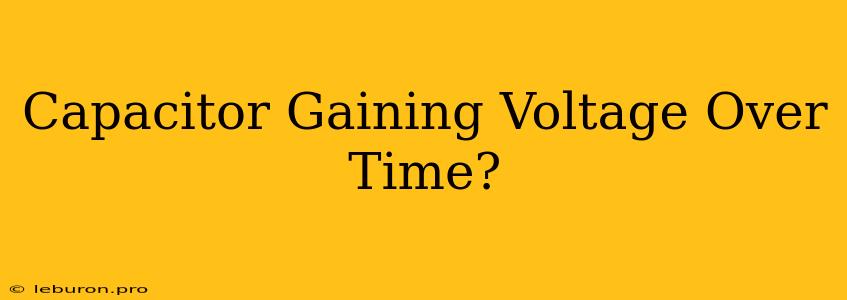Understanding Capacitor Voltage Rise: A Comprehensive Guide
Capacitors, fundamental components in electronics, play a crucial role in storing electrical energy. This stored energy is released when needed, making capacitors essential in circuits for tasks ranging from smoothing power supplies to filtering signals. One of the most intriguing aspects of capacitor behavior is their gradual voltage rise when connected to a voltage source. Understanding how a capacitor gains voltage over time is critical for optimizing circuit design and ensuring proper functionality.
The Fundamentals of Capacitor Charging
At its core, a capacitor consists of two conductive plates separated by an insulating material called a dielectric. When a voltage is applied across these plates, an electric field is created within the dielectric. This electric field effectively stores energy, and the amount of energy stored is directly proportional to the capacitance of the capacitor and the square of the voltage across it.
Capacitance: The ability of a capacitor to store energy is quantified by its capacitance, measured in Farads (F). Higher capacitance means the capacitor can store more energy at a given voltage. The capacitance depends on the physical properties of the capacitor, including the area of the plates, the distance between them, and the dielectric constant of the insulating material.
Voltage: The voltage across a capacitor represents the potential difference between its plates. This voltage determines the amount of energy stored in the capacitor.
The Charging Process: A Time-Dependent Phenomenon
When a capacitor is connected to a voltage source, it doesn't instantly charge to the full source voltage. Instead, the voltage across the capacitor gradually increases over time. This gradual increase is governed by the time constant (τ), which characterizes the charging rate.
Time Constant (τ): The time constant represents the time it takes for the capacitor voltage to reach approximately 63.2% of the source voltage. It is determined by the product of the capacitor's capacitance (C) and the resistance (R) in the circuit:
τ = RC
Resistance (R): The resistance in the circuit plays a crucial role in limiting the charging current. A higher resistance results in a slower charging rate.
The Exponential Rise: A Mathematical Description
The charging of a capacitor is an exponential process. The voltage across the capacitor (Vc) as a function of time (t) is given by the following equation:
Vc(t) = Vsource(1 - e^(-t/τ))
Where:
- Vsource: The voltage of the source.
- e: The mathematical constant approximately equal to 2.718.
Charging Curve: The charging curve of a capacitor is a graph of voltage (Vc) versus time (t). This curve is exponential in nature, starting at 0V and gradually approaching the source voltage (Vsource) asymptotically.
Factors Affecting Charging Time
Several factors influence the charging time of a capacitor:
-
Capacitance: A larger capacitance value leads to a longer charging time because a larger capacitor can store more energy.
-
Resistance: Higher resistance values result in a slower charging rate due to the lower current flow.
-
Source Voltage: A higher source voltage leads to a higher final voltage across the capacitor.
-
Dielectric Strength: A dielectric material's ability to withstand a high electric field determines its voltage rating. Higher dielectric strength allows for faster charging rates because it can handle larger voltage differences.
Applications of Capacitor Charging
Capacitor charging plays a vital role in numerous electronic applications, including:
-
Power Supply Filtering: Capacitors are used to smooth out voltage fluctuations in power supplies, providing a more stable output.
-
Timing Circuits: The charging and discharging characteristics of capacitors are exploited in timing circuits such as RC oscillators and time-delay circuits.
-
Energy Storage: Capacitors are increasingly being utilized in energy storage applications, such as in hybrid electric vehicles and renewable energy systems.
-
Pulse Shaping: Capacitors can be used to shape pulses, smoothing out sharp edges and increasing the duration of pulses.
Conclusion
Understanding the charging process of a capacitor is crucial for both novice and seasoned electronics enthusiasts. The time constant (τ) effectively dictates the charging speed, and its value is determined by the combination of capacitance and resistance. By understanding the relationship between these factors, engineers can design efficient circuits that leverage the unique capabilities of capacitors for various purposes, from smoothing power supplies to storing energy for future use.
